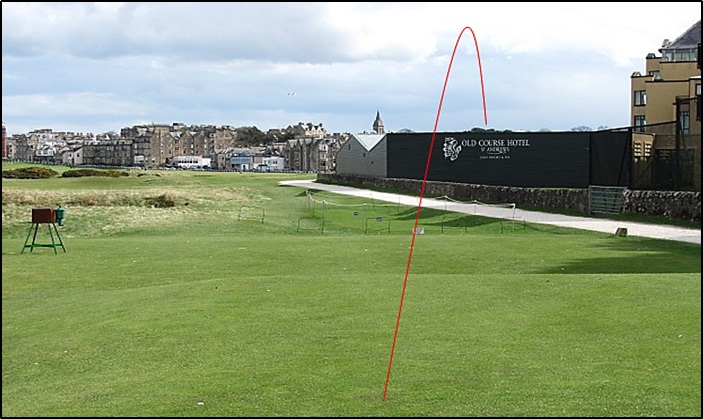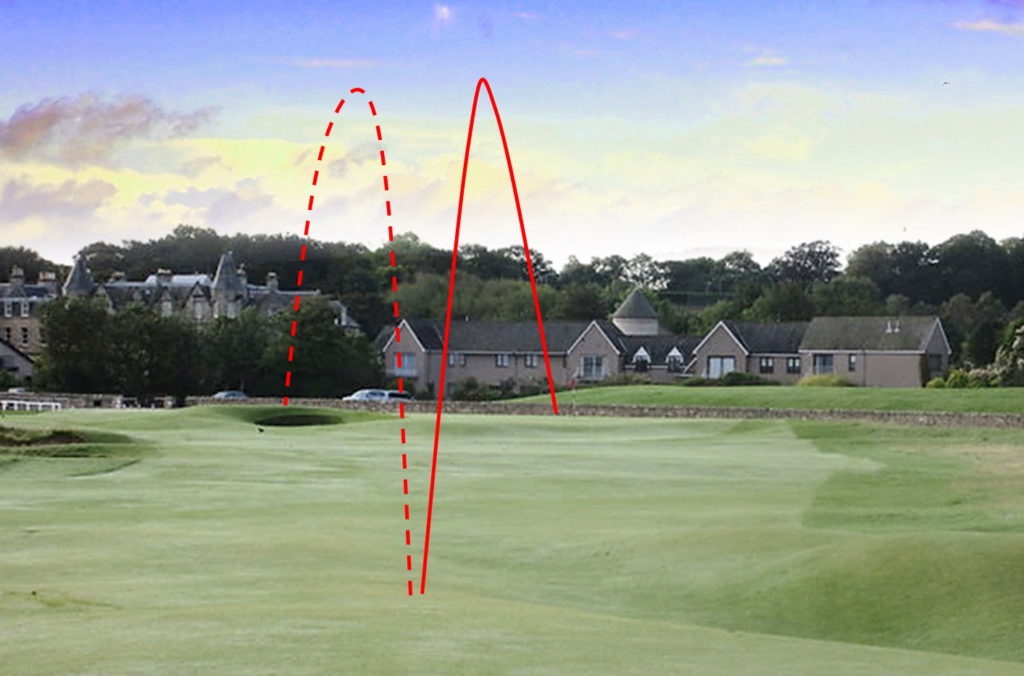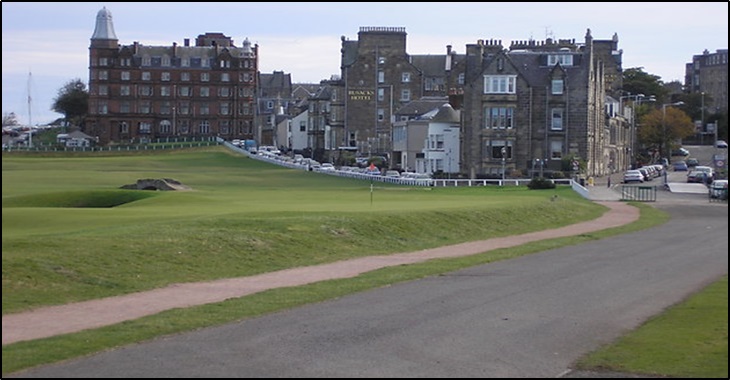
Image by Kevin Murray. To view some of Kevin’s work from around the world [CLICK] 
The St Andrews Road Hole is one of golf’s ‘great holes’ and yet the anatomy of a great hole is never easy to completely dissect, yet alone bottle. There are a few things however which can certainly give it a boost.
1: Where it sequentially features on a course.
2: The realistic possibility of all three scores being achieved
3: A number of different things that can go wrong
The 17th at St Andrews ‘the Road Hole’, passes the first of these requirements by definition. The Road Hole possibly falters a little bit on the second parameter however. Since it was lengthened from a sporting 445yds to a brutal 495yds, birdies have been an increasingly endangered species. We said “all three scores” though? Well perhaps we could interpret that as meaning ‘par’, ‘bogey’ and ‘double’! OK, so with a bit of license we’ve ticked the second box as well. It’s the third requirement where it distinguishes itself however.
So let’s take a step-by step look at this score wrecker
There was a time when the trauma started with the dilemma faced on the tee. The shot plays blind over the old railway sheds, now the hotel. Club selection was the key. The conservative option was to play to the wider top of the fairway and slightly left. A drive of 260yds onto the larger landing strip however, would still leave you a perilous 235yds to the flag into a narrow green. You could postpone the difficult shot from the tee, but you couldn’t avoid having to play one at some point. There is a higher risk option. As the fairway advances towards the green, it starts to narrow. The hotel to the right is out of bounds, and anything hit too far left is likely to fall into the long rough which will nearly always prevent you reaching the putting surface in two (unless your name is Seve!).
If you play longer, and succeed in finding the narrower fairway on 280yds, you’re left with a 2nd shot of about 210yds; easy! Golfer’s who frequently surveyed their second from the safer yardage would begin to wonder whether they’d actually assigned themselves something closer to the more impossible of two choices.

An orthodoxy started to develop that the lower risk was to play the higher risk tee shot, such was the difficulty of the second when playing safe. Ultimately modern equipment started to swing the pendulum in favour of the aggressive line, but then the empire struck back when the R&A moved the tee back 50yds for the 2015 Open.
You won’t be able to see where you’ve landed from the tee. It’s only as you round the corner into the fairway that you’ll get the telegram that tells you the good or bad news. This was what Tom Watson faced in 1984 when going head to head with Seve Ballesteros. Against conventional commentator opinion, it was the more conservative Watson who elected to gamble and go aggressive. The supposedly cavalier Spaniard by contrast played safe. As Tom walked into the fairway, he learned he was in position ‘A’. His ball had found the spot for a perfect approach.
Seve’s by contrast dumped his short, and in the hay. A horrible second awaited. Surely a sixth Open awaited the American, and an unprecedented clean sweep of the Scottish roster?
The first thing to notice about your second shot is the actual green itself. The geometry of the green is also working against you. Viewed from above it resembles a figure-eight, peanut, with bulbous ends and a slender middle. Playing to the nearest of these bulges leaves a lengthy putt over a ridge with little prospect of anything better than a par. Trying to hit the middle section is hideously difficult. Not only is it a mere 16yds in width to land on, it is brutally defended by two of the most famous hazards in golf.
In the front lies ‘the Road Hole Bunker’. It’s deceiving. The bunker itself is small in area, but deep and steep. It tapers like a hole on a pinball machine, and therefore plays appreciably bigger than it is. Any ball bouncing or rolling too close will invariably be snaffled by it. A bit like a trap-door spider. It’s a bunker you don’t have to ‘hit’ to end up in. Just getting near enough, within its magnetic pull, and the chances are you’ll roll into it
In 1970 Doug Sanders played what Jack described as the best bunker save he’d ever seen when chipping out to inches. Surely the claret jug was his? Well no. His fate is well documented and unravelled with one of golf’s greatest ever missed putts on 18 some fifteen minutes later.
In 1979 Tommy Nakajima led the Open before becoming acquainted. He took four shots to execute his escape leading to the British press corps to dub the bunker, ‘The Sands of Nakajima’. The name didn’t last, but the story endures. In 1995 it was the bunker that decided the fate of the Open again. In regulation play John Daly blasted out from an improbable lie to limit the damage. An hour later it would be Costatino Rocca who faced the same shot in a play off with the American. Rocca needed two attempts. Daly sailed to the title

The approach shot,. The Road Hole bunkers lies in front, with the perimeter wall visible behind. The pin position in the photo is the generous one. The tournament location is the one behind the bunker in the narrowest part of the putting surface. The wise bail out to the right onto the bulbous part of the green and settle for a 40 ft putt
– Image by Kevin Murray
The threat isn’t restricted to the front of the green though. If anything the area behind is defended even more aggressively. The green itself has a fairly steep swale. In itself this isn’t a problem. It’s just that this one leads onto a road. A golf ball wasn’t decided to hold on tarmac. Anything the lacks elevation and comes in on a shallow angle risks kissing the surface and skipping through. The Road Hole isn’t finished with you though. A limestone wall runs behind the road. As the ball picks up speed on the tarmac it will nearly always hit the wall. A strong ricochet might bounce you clear. A deadening one however leaves you tight against the wall with potentially no back swing.

In 1984, having hit an exemplary tee shot, this was the fate that would befall Tom Watson. He elected a club too heavy and simply hit the green bounced into the road, crashed into the wall, and came to rest in a position that would only permit a limited jabbing shot. Ballesteros somehow conjured an improbable escape from the rough and found the green. The Scottish set eluded Watson. History denied golf, and golf, history. We’re far from convinced Watson ever fully recovered. He’d won his last Major.
One shot Watson did have available to him incidentally, is one of the classic shots in golf and unique to this hole. This involves turning your back on the green and playing straight into the wall itself with the view to affecting a rebound off the rock and back across the road to the green. An Open championship will normally see someone attempting this escape. Miguel Angel Jiminez famously saved himself doing this.
One of the great beauties of golf is that it’s a slow burn. A punitive hole should perhaps offer the golfer a chance of recovering on a sliding scale of difficulty commensurate to their error. The 17th at Sawgrass for example is just one shot and lacking in subtlety. It’s either on the green to cheers, or it’s in the water (usually to cheers as well!). Then it’s over. It doesn’t pose the riddle of ‘what you’re going to do next?’. That can only be asked if the ball stays in play and has the scope to ask many different questions dependent on where it’s come to lie.







